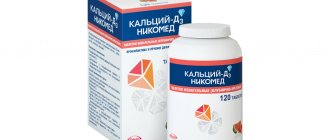Complivit Calcium D3 forte
Double 3 dose of vitamin D3 and calcium to strengthen bones in adulthood!
- Contains double3 dose of vitamin D3 and calcium for better absorption in adulthood1
- Helps strengthen bones, maintain muscle strength for beautiful posture and easy gait
- Designed for the prevention and complex therapy of osteoporosis
To ensure the absorption of calcium and metabolic processes in bone tissue, vitamin D is required. The content of vitamin D in the body depends on many factors. Vitamin D synthesis occurs in the skin under the influence of ultraviolet rays and depends on skin pigmentation, latitude of the region, length of day, time of year, weather conditions and the area of skin not covered by clothing. In winter, in countries located at northern latitudes, most of the ultraviolet radiation is absorbed by the atmosphere and the synthesis of vitamin D in the skin is practically absent8.
Vitamin D is an important vitamin that is involved in regulating many other processes in the body 1,4-8. It is involved in the regulation of muscle tone, in maintaining the body's antitumor defense, glucose and insulin metabolism, blood pressure levels, and thyroid function. Another important function of vitamin D is its participation in maintaining immunity. Vitamin D is a potential immunomodulator and is involved in the regulation of the body's immune response to various infectious diseases.
With age, after 50 years, there is a decrease in the skin's ability to produce vitamin D. Combined with decreased sun exposure, this leads to a decrease in serum vitamin D levels, which contributes to the development of osteoporosis and, as a result, an increased risk of fractures.
Osteoporosis is the leading cause of fractures in men and women over age fifty and is a growing problem. Every third woman over the age of 45–50 and almost half of all men and women over 65 are faced with the problem of brittle bones. And the frequency of vitamin D3 deficiency among the Russian population reaches 83%.1
According to the latest recommendations,2 people over 50 years of age need to take 1000-1200 mg of calcium and 800 IU of vitamin D3 to prevent osteoporosis and its consequences.
Just two Complivit® Calcium D3 forte tablets contain 1000 mg of Calcium and twice as much Vitamin D3: 800 IU. To replenish the daily requirement of calcium and vitamin D3, as well as for the prevention and complex treatment of osteoporosis and its complications (fractures).
Compound
Calcium 500 mg (as carbonate) + 400 IU Vitamin D3
Release forms
Chewable tablets with mint flavor, No. 30, No. 60, No. 100, No. 120
Indications for use
Prevention and complex therapy of osteoporosis and its complications (fractures).
Prevention and treatment of calcium and/or vitamin D3 deficiency.
Complivit® Calcium D3 forte is approved for use in adults and children over 3 years of age.
Calcium-D3-MIK forte
Pharmacodynamics
Calcium-D3-MIC forte is a combination drug that regulates the metabolism of calcium and phosphorus.
Calcium is a vital mineral element necessary to maintain the balance of electrolytes in the body and the adequate functioning of regulatory mechanisms. Calcium carbonate is involved in the formation of bone tissue, is necessary for the mineralization of teeth, regulation of nerve conduction, muscle contractions, maintaining stable cardiac activity and is a component of the blood coagulation system. Calcium (in ionized form and in the form of complexes) plays a key role in cell division and differentiation, conduction of nerve impulses and in the contraction-relaxation cycle (together with tropin) of smooth and striated muscles, transmembrane ion reactions involving selective calcium channels, activity neuroselective organs, the production and effects of a number of hormones, enzymes and other protein, as well as non-protein biologically active substances. The participation of calcium in such diverse processes is explained by its universal function as a secondary messenger (transmitter) that transmits and implements a biological signal in various types of cells.
Vitamin D3 stimulates the absorption of calcium and phosphorus in the intestines, the reabsorption of calcium and phosphorus in the kidneys, the transport of calcium through membranes and cells, the development of the immune system, cell proliferation and differentiation, the synthesis of lipids and a number of hormones, the functional activity of the cardiovascular system and gastrointestinal tract , reduces the level of parathyroid hormone in the blood. It is necessary for the normal functioning of the parathyroid glands and takes part in the synthesis of ATP.
Vitamin D3 and its active metabolites have a multifaceted effect on bone tissue: they increase the absorption of calcium in the intestine, stimulating the synthesis of calcium-binding proteins; increase calcium reabsorption in the renal tubules; activate bone remodeling processes by increasing the synthesis of collagen I and matrix proteins, by activating the synthesis of osteoblasts; improve bone quality by influencing osteoclast activity; regulate the secretion of parathyroid hormone by two mechanisms: directly suppressing the proliferation of parathyroid cells and through increasing the level of calcium in the blood; stimulate the differentiation of cells - precursors of bone and cartilage tissue; have a positive effect on neuromuscular conduction through the regulation of calcium channels and protein kinase A activity.
The use of a combination drug containing calcium and vitamin D3 is justified, since vitamin D3 increases the absorption of calcium in the intestine and the combined use of calcium and vitamin D3 prevents an increase in the production of parathyroid hormone (PTH), which is a stimulator of increased bone resorption (leaching of calcium from the bones).
Thus, Calcium-D3-MIC forte regulates the exchange of calcium and phosphates, reduces resorption and increases bone density, compensates for the lack of calcium and vitamin D3 in the body, enhances the absorption of calcium in the intestines and the reabsorption of phosphates in the kidneys, and promotes bone mineralization.
Pharmacokinetics
Calcium. Calcium absorption occurs in the duodenum, jejunum and colon. This process is carried out with the participation of two mechanisms: active absorption and passive diffusion, with the participation of which less than 10% of the element supplied with food is absorbed. The main regulator of active absorption is the vitamin D metabolite, calcitriol, which stimulates the biosynthesis of calcium-binding proteins in intestinal enterocytes. After being absorbed into the systemic circulation, calcium is distributed among organs and systems and primarily enters bone tissue.
Under physiological conditions, the excretion of calcium from the body (except for the part excreted in feces that is not absorbed in the intestine) is approximately 250–300 mg per day, which includes 140–180 mg that has not undergone reabsorption in the kidneys and enters the urine, as well as 80–100 mg, excreted into the intestines with bile and pancreatic secretions.
Calcium absorption increases during pregnancy and lactation.
Penetrates the placental barrier and is excreted in breast milk.
Cholecalciferol. Absorption of cholecalciferol occurs in the small intestine in the presence of bile. Usually 50-70% of the taken dose of the vitamin is absorbed. Incomplete absorption is observed with obstructive jaundice and severe steatorrhea.
The maximum concentration is reached after 8-18 hours. From the bloodstream, about 70% of vitamin D3 is absorbed by the liver, where it is metabolized. The resulting metabolite (25-hydroxycholecalciferol) is transported to the kidneys, where the formation of biologically active compounds occurs, among which 1,25-dihydroxycholecalciferol (1,25 (OH)2 D3) and 24,25-dihydroxycholecalciferol (24, 25 (OH)2D3).
The metabolism of cholecalciferol is disrupted in chronic renal failure, with the prescription of protein synthesis inhibitors (actinomycin, glucocorticoids), with long-term use of phenobarbital and diphenine.
Vitamin D3 has cumulative properties. It accumulates in the liver in non-parenchymal cells, from where it is transported to hepatocytes, where it is metabolized.
Penetrates the placental barrier and is excreted in breast milk.
T1/2 from blood plasma is up to several days and may be longer in case of impaired renal function.
In elderly patients, renal function may decrease, which should be taken into account when dosing the drug.
In patients with chronic liver failure, hypocalcemia may be a consequence of a decrease in the synthesis in the liver of 25-hydroxy-cholecalciferol as a substrate for the formation of 1,25-dihydroxy-cholecalciferol in the kidneys, that is, a vitamin D hormone that increases the intestinal absorption of ionized calcium.
Chronic renal failure is accompanied by a decrease in the synthesis of vitamin D hormone, which in some patients causes hypocalcemia. In patients with nephrotic syndrome, urinary loss of 25-hydroxycholecalciferol leads to hypocalcemia. Hypocalcemia due to loss of 25-hydroxycholecalciferol can be caused by a blockade of its physiological circulation between the intestinal lumen and the liver, due to a decrease in intestinal absorption.
Buy Complivit Calcium D3 Forte chewable mint tablets No. 100 in pharmacies
Instructions for use
Complivit Calcium D3 Forte Mint tab. chewing No. 100
Dosage forms
chewable tablets (mint)
Group Multivitamins with macro- and microelements International nonproprietary name No INN. Manufacturers Pharmstandard-Ufa Vitamin Plant (Russia)
Ingredients : Calcium 500 mg (as carbonate) + 400 IU Vitamin D3
Release form: chewable tablets (mint)
№30 №100 Indications for use:
Prevention and complex therapy of osteoporosis and its complications (fractures). Replenishment of calcium and/or vitamin D3 deficiency. Complivit® Calcium D3 forte is approved for use in adults and children over 12 years of age.
Vitamin D is required to ensure calcium absorption and metabolic processes in bone tissue. Vitamin D levels depend on many factors. Vitamin D synthesis occurs in the skin under the influence of ultraviolet rays and depends on skin pigmentation, latitude of the region, length of day, time of year, weather conditions and the area of skin not covered by clothing. In winter, in countries located at northern latitudes, most of the ultraviolet radiation is absorbed by the atmosphere and the synthesis of vitamin D in the skin is practically absent.
With increasing age, there is a decrease in the level of vitamin D in the blood serum, progression of kidney failure, decreased sun exposure and a decrease in the skin's ability to produce vitamin D, which leads to the development of osteoporosis and, as a consequence, to fractures. According to the latest recommendations, people over 50 years of age need to take 1000-1200 mg of calcium and 800 IU of Vitamin D3 to prevent osteoporosis and its consequences.
Complivit® Calcium D3 forte is a new formula of a well-known drug.
Just two Complivit® Calcium D3 forte tablets contain 1000 mg of Calcium and twice as much Vitamin D3: 800 IU.
Contraindications
Hypersensitivity to the components of Complivit calcium D3, hypercalcemia, hypercalciuria, calcium nephrourolithiasis, hypervitaminosis D, decalcifying tumors (myeloma, bone metastases, sarcoidosis), osteoporosis due to immobilization, phenylketonuria (contains aspartame), pulmonary tuberculosis (active form), chronic renal failure , children under 3 years of age. special instructions
During the treatment period, it is necessary to constantly monitor the excretion of Ca2+ in the urine and the concentration of Ca2+ and creatinine in plasma (in the event of calciuria exceeding 7.5 mmol/day (300 mg/day), it is necessary to reduce the dose or stop taking it).
Contains aspartame, which is metabolized in the body into phenylalanine, which must be taken into account in patients suffering from phenylketonuria.
To avoid overdose, additional vitamin D3 intake from other sources must be taken into account. Do not use simultaneously with vitamin complexes containing Ca2+ and vitamin D3.
In elderly people, the need for Ca2+ is 1.5 g/day, for vitamin D3 - 0.5-1 thousand IU/day. Compound
1 tablet contains calcium (in the form of calcium carbonate - 1.250 g) 500 mg, colecalciferol (Vitamin D3) 200 IU in the form of a granulate containing: colecalciferol, butyl hydroxytoluene, sucrose, gelatin, sodium aluminosilicate, medium chain triglycerides, modified starch, water; excipients: milk sugar (lactose), low molecular weight polyvinylpyrrolidone (povidone), potato starch, Vivasol (croscarmellose sodium), citric acid, aspartame, magnesium stearate, orange flavor (powder); Directions for use and doses
Orally, chew or swallow whole, mainly during meals, or individually depending on the clinical picture.
Adults: for the treatment of osteoporosis - 1 tablet 2-3 times a day, for the prevention of osteoporosis - 1 tablet 2 times a day.
To compensate for calcium and/or vitamin D3 deficiency:
— Adults and children over 12 years old — 1 tablet 1-2 times a day.
- Children from 3 to 12 years old - 1 tablet per day or as prescribed by a doctor.
Side effects
Constipation, flatulence, nausea, stomach pain, diarrhea. Hypercalcemia and hypercalciuria. Allergic reactions. Drug interactions
Reduces the absorption of bisphosphonates, sodium fluoride and tetracyclines (the interval between doses is at least 2-3 hours).
Increases the risk of developing toxicity of cardiac glycosides (monitoring of the ECG and the patient's condition is necessary).
Phenytoin, barbiturates, corticosteroids reduce the effect of vitamin D3, vitamin A - toxicity.
GCS reduce Ca2+ absorption.
Cholestyramine, laxatives (vaseline oil) reduce the absorption of vitamin D.
Thiazide diuretics increase the risk of hypercalcemia.
Furosemide and other loop diuretics increase Ca2+ excretion by the kidneys. Overdose
Symptoms (after taking 200 chewable tablets): thirst and polyuria (as signs of chronic renal failure), decreased appetite, nausea, vomiting, constipation, dizziness, weakness, headache, fainting, coma; with long-term use: calcification of blood vessels and tissues. Laboratory indicators in case of overdose: hypercalciuria, hypercalcemia (Ca2+ in plasma about 2.6 mmol).
Treatment: rehydration, loop diuretics, corticosteroids, calcitonin, bisphosphonates, Ca2+-restricted diet, hemodialysis. Storage conditions
In a place protected from light, at a temperature not exceeding 25°C. Best before date
2 years Active ingredient
Calcium carbonate, Colecalciferol Conditions for dispensing from pharmacies
Over the counter


